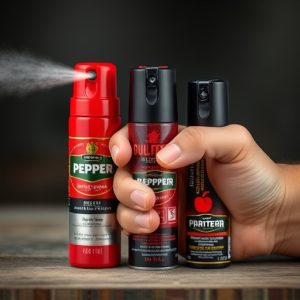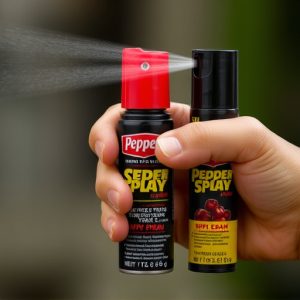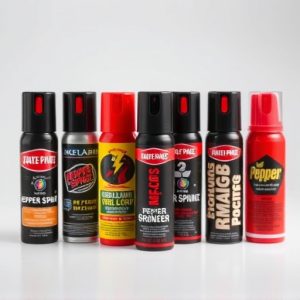Decoding Pepper Spray Pricing: A Market Analysis by Leading Manufacturers
Pepper spray pricing is influenced by a complex interplay of market dynamics, including supply and …….
Pepper spray pricing is influenced by a complex interplay of market dynamics, including supply and demand, regulatory compliance, industry competition, and consumer preferences. Manufacturers balance cost-efficiency, innovation, and quality to maintain competitive positions, with operational costs, research and development, and geographic presence all impacting the final product price. Regulatory factors add complexity due to varying regional legal requirements that can increase production costs. Market trends, such as demand spikes in volatile times or high-crime regions, cause pricing fluctuations. Enhanced features like GPS tracking or longer shelf lives can also affect cost structures. The cost of pepper spray is particularly affected by the global price fluctuations of high-grade peppers used in formulations and R&D investments for safety, efficiency, and new product development. Manufacturing costs, including quality control, packaging, and distribution, are critical and can be offset somewhat by economies of scale in larger operations. Local factors like labor expenses, environmental regulations, and trade tariffs further influence production costs. As a result, consumers will find a wide range of pricing for pepper spray products, reflecting these various cost considerations. When purchasing pepper spray, it's important to consider brand reputation, product features, ingredients, potency, safety features, and design, which all impact the cost. Consumers should weigh efficacy, reliability, and additional safety features against price for the best value. Buying directly from manufacturer websites or authorized distributors can help avoid middleman fees, and keeping an eye out for sales and promotions can lead to significant savings. For those needing multiple units, volume discounts are available, making bulk purchases a cost-effective self-defense option.
navigating the market for self-defense products, one encounters a range of pricing strategies for pepper spray. This article dissects the factors influencing the costs set by pepper spray manufacturers and explores the dynamics shaping the market. From production techniques to brand reputation, we delve into the elements that affect pepper spray prices. Consumers will benefit from understanding these factors to make informed purchases and secure their safety at competitive rates from reputable manufacturers. Join us as we examine the pricing landscape of this critical personal defense tool.
Understanding the Market Dynamics of Pepper Spray Pricing
The pricing of pepper spray, a widely used self-defense product, is influenced by a variety of market dynamics that are shaped by both supply and demand factors. Manufacturers of pepper spray are a pivotal component in this ecosystem, as their production costs, scale of operation, and geographic location can significantly impact the retail price points. These entities invest in research and development to improve formula efficiency and effectiveness, which can either increase or decrease prices based on the innovation’s scale and implementation. Additionally, the competitive landscape within the pepper spray industry drives manufacturers to balance cost-efficiency with quality to maintain a competitive edge.
Market dynamics also consider regulatory factors, as the production and distribution of pepper sprays are subject to various legal restrictions that vary by region. Compliance costs can be factored into the pricing structure, especially when manufacturers must adapt to different standards across international borders. Furthermore, market trends such as the increasing demand for personal safety products during uncertain times or in high-crime areas can lead to price fluctuations. Consumers’ willingness to pay more for enhanced features like GPS tracking or longer shelf life may also drive up costs. Understanding these complex factors is crucial for both manufacturers and consumers to navigate the market effectively, ensuring that pricing reflects quality, cost of production, and the value provided by each pepper spray product on the market.
Factors Influencing Costs by Pepper Spray Manufacturers
The cost of pepper spray, produced by various pepper spray manufacturers, is influenced by a multitude of factors that dictate both production and market pricing. Raw material costs are a significant determinant; high-grade peppers required for the formulation are not uniformly priced globally, with fluctuations in agricultural markets directly impacting the base cost. Additionally, manufacturers must consider the expenses associated with research and development, which include the design of new pepper spray models, improvements to safety and efficiency, and the compliance with ever-evolving regulatory standards. These R&D costs are often amortized into the final product price.
Production and operational costs also play a pivotal role in shaping the pricing strategy of pepper spray manufacturers. This encompasses everything from sourcing raw materials to maintaining high standards of quality control, packaging, and distribution. Economies of scale can reduce costs for larger manufacturers, but they may pass some of these savings on to consumers in competitive markets. Moreover, geographical factors such as regional labor costs, local environmental regulations, and tariffs can influence the overall production cost, thereby affecting the price point of the end product. As a result, consumers often see a range of prices for pepper spray across different brands and models, reflecting these diverse influencing costs.
Analyzing the Price Variations Among Leading Pepper Spray Manufacturers
When examining the price landscape of pepper spray among leading manufacturers, it’s evident that several factors influence the cost. The market for self-defense products is competitive, with a variety of companies vying for consumer attention. Prices can vary significantly based on brand reputation, product features, and the quantity purchased. For instance, well-established pepper spray manufacturers with a strong brand presence often command higher prices due to their perceived quality and customer trust. On the other hand, emerging brands might offer competitive pricing, which can be appealing to budget-conscious consumers. These cost differences are further influenced by the ingredients used, the potency of the spray, additional safety features, and the overall design of the pepper spray device. It’s also worth noting that certain manufacturers invest in advanced production techniques or innovative sprays that can affect the final price. Consumers looking to purchase pepper spray should consider not only the cost but also the efficacy and reliability of the product, as well as any additional safety features offered by different manufacturers. By comparing prices across various brands, individuals can make an informed decision based on their specific needs and budget constraints.
Strategies for Purchasing Pepper Spray at Competitive Prices from Trusted Manufacturers
When considering the acquisition of pepper spray, a product that demands both reliability and affordability, consumers are advised to employ strategic approaches to secure competitive prices while ensuring they purchase from reputable manufacturers. One effective strategy is to conduct thorough research on the various pepper spray manufacturers available in the market. These manufacturers often have different price points based on factors such as brand reputation, quality of the product, and additional features like gel or foam variants. By comparing these aspects across multiple manufacturers, consumers can identify which brands offer the best value for their pepper spray products.
Additionally, purchasing directly from the manufacturers’ websites or authorized distributors can often result in lower prices due to the absence of middleman markups. Sales and promotions are frequently offered by manufacturers to clear out older stock or introduce new products, providing opportunities for savvy shoppers to procure pepper spray at discounted rates. Furthermore, bulk purchases may come with volume discounts, making this an economical option for those who need multiple units of pepper spray for personal safety or professional use. Keeping an eye on these manufacturers’ sales and taking advantage of discounts can lead to significant savings while still ensuring the purchase of a quality self-defense product.


